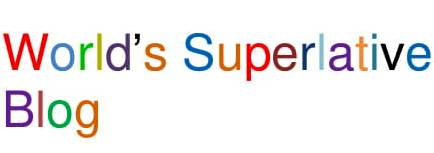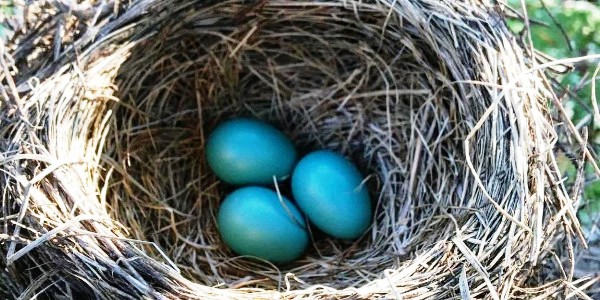What Does the Mama Bird See?
The trees are budding out. Spring is here. This reminds me that while pruning the wisteria last spring, I noticed a beautiful robin’s nest tucked between several twisting vines. I brought the ladder closer and climbed up to see three perfect eggs (robin’s egg blue, as it happened). In retrospect, I realized I’d heard a bird vigorously tweeting as I was trimming; at the time I’d thought how nice it was to hear such sweet birdsong. But there was nothing sweet about it–I was oblivious to the distress the frantic mother bird had been communicating.
Over the next few days I often forgot about the nest, and mindlessly clomped across the deck to check the rain gauge or turn on the hose. The commotion I generated caused the poor mama to flee in panic and sing her song of fear. And no matter how I tried to tell her that I meant no harm, she wasn’t reassured.
As time passed, I more consistently remembered the nest. I gave it a wide berth and tried to be quieter; the bird stopped fleeing when I approached. Still, she remained on guard: her alert beak and bright eyes stuck out of the nest in one direction, her tail in the other. But she stayed on her eggs. It gave me pleasure to know that she now trusted—or at least tolerated—my presence enough not to take flight.
As she lay atop her three babies-to-be, immobile but wary, it occurred to me how different her perceptions were from mine. What did she see as she looked out from her nest? Perhaps she classified the immediate world into: 1) food source, 2) safe shelter, and 3) potential threat. Moreover, she was almost certainly multilingual to all the bird chatter around us, effortlessly understanding the messages encoded in the raucous cawing of the crows, the scratchy call of the Steller’s Jay, and the peeping of the flicker. At the same time, she was undoubtedly oblivious to things in her vicinity that were important to me: that a spot on the deck had been missed when it was repainted, that the gutters needed to be cleaned out, and that the lawn was in desperate need of mowing.
When I stood quietly beneath her nest, listening for signs that the baby birds had hatched, the mama robin and I were occupying the same physical space. But the reality mapped onto my human brain looks nothing like the one mapped onto her bird brain. Each map served us well, but there was probably only tangential overlap.
Finally, the hatchlings emerged. They stuck their beaks up to the sky, opening and closing them like miniature pruning shears, in anticipation of the early worm. And speaking of baby birds, it occurs to me that not only do the mama robin and I see the world through vastly different eyes, but a baby robin’s Map of the World is almost certainly quite different from that of her mama’s. For example, the mama food map prominently identifies the most fertile worming grounds; the baby’s centers on the mama’s loaded beak. The mama is constantly vigilant for signs of danger; the baby probably doesn’t even have danger-detecting neurons wired up yet.
And, of course, this is just as true for humans as for birds. Like baby birds, when my kids were small, they saw the world radically differently than I did. And in some ways, they still do. And, come to think of it, so does every person in the world. A farmer looks up at the sky and knows he needs to harvest the wheat right away; an artist looks at the same sky and thinks how lovely the clouds with their pretty gray edges are. A radiologist sees clear evidence of congestive heart failure on the chest x-ray; her office manager looks at it and sees blurry shadows. One person walks in the forest and is struck by the unusual comingling of different species of trees; another is overwhelmed by the beauty of God’s creation.
We are each equipped with a unique map of the world, along with rules for how to navigate it. Being mindful of these differences may help us to be more generous to others for the things they say and the decisions they make. We are quite aware of and make allowances for the difference in perceptions between us and our feathered friends; seems like it’s not a stretch to do so for our fellow humans as well.




So well said, Ken. And such a beautiful photograph!
We indeed each have a different place from which to view what we view, and then do what we do. In the best outcome, this should create a colorful patchwork of cooperation, a covering of understanding, and a sensitivity to the reactions to our actions, just like you did with Mama Bird.
Thank you for this delightful yet thought-provoking post!
Loved this, Ken! I am always keenly aware that what I am looking at is probably quite different than what I am actually “seeing.” What takes my breath away may not be noticed by others, but I am also fearful of not noticing what I should….
Another beauty Kenneth! Back in another lifetime I had an English Prof from Berkeley, Dr Mel Fabre, who used to sit on his desk and encourage us to look for the most obscure person, item, living creature, or activity in a novel or story and develop a paper explaining the significance of its existence. He would have been given you an A+ for this latest creation! Very enjoyable!!
Ken, Pure poetry! And, with a clear message. When I reflect upon your themes, I sense that my ambient stress is reduced. Wisdom is soothing. Thanks for sharing yours with us! Carl
We recently discovered a killdeer nest (if you can call it that) – a quickly dug depression in beauty bark, in a parking lot island completely devoid of plants or other hiding spots – with three eggs resembling rocks. My thought was, why on earth would these birds pick such an exposed place for their offspring? A place so easily trampled or robbed by predators? Their perspective is different than mine, of course, but I’d like to give them some parenting advice. 🙂